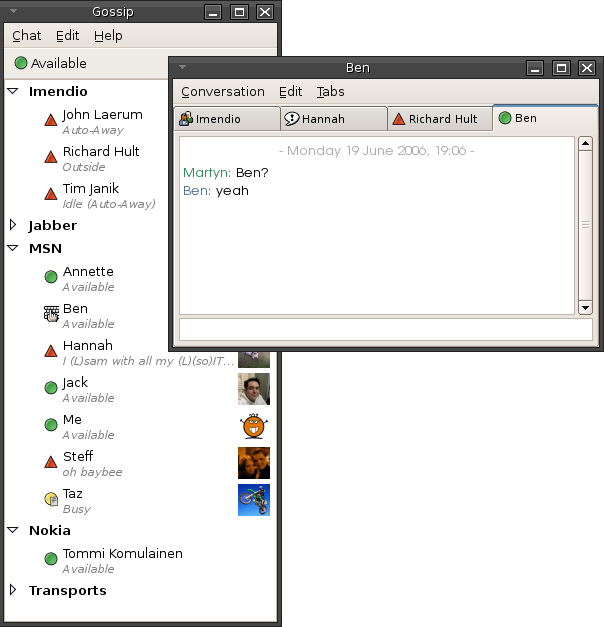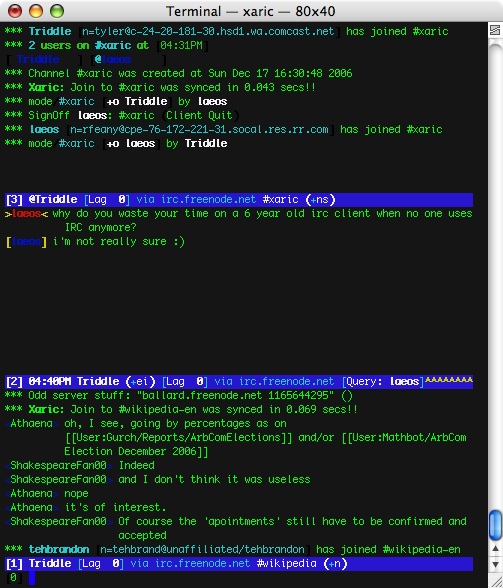|
Filetopia
Filetopia is a free, multi-platform peer-to-peer file sharing client and networking tool that allows users to share files and send instant messages to others. Users can share files in public chat rooms or privately with contacts. History Filetopia software development started in October 1998, and the first public beta was released in March 1999. The classic Filetopia software version was 3.04d, 2002. In 2003, Filetopia v3.04 was reviewed in ''PC Magazine'' and rated 3/5. In 2004, the author of Filetopia was interviewed on the website Slyck.com. In April 2012, development began on a project to completely rewrite the program in JavaFX. This version was eventually released as Filetopia FX. Filetopia FX (from 2015) Filetopia FX no longer allows global-wide file searching and instead encourages meeting new people. It is a complete rewrite of the original. In this version, the maximum file size limit of 2 GB was removed; users gained the ability to post images and HTML fragmen ... [...More Info...] [...Related Items...] OR: [Wikipedia] [Google] [Baidu] |
Chat Room
The term chat room, or chatroom (and sometimes group chat; abbreviated as GC), is primarily used to describe any form of synchronous conferencing, occasionally even asynchronous conferencing. The term can thus mean any technology, ranging from real-time online chat and online interaction with strangers (e.g., online forums) to fully immersive graphical social environments. The primary use of a chat room is to share information via text with a group of other users. Generally speaking, the ability to converse with multiple people in the same conversation differentiates chat rooms from instant messaging programs, which are more typically designed for one-to-one communication. The users in a particular chat room are generally connected via a shared internet or other similar connection, and chat rooms exist catering for a wide range of subjects. New technology has enabled the use of file sharing and webcams. History The first chat system was used by the U.S. government in 1 ... [...More Info...] [...Related Items...] OR: [Wikipedia] [Google] [Baidu] |
JavaFX
JavaFX is a software platform for creating and delivering desktop applications, as well as rich web applications that can run across a wide variety of devices. JavaFX has support for desktop computers and web browsers on Microsoft Windows, Linux (including Raspberry Pi), and macOS, as well as mobile devices running iOS and Android, through Gluon Mobile. With the release of JDK 11 in 2018, Oracle made JavaFX part of the OpenJDK under the ''OpenJFX'' project, in order to increase the pace of its development. Open-source JavaFXPorts works for iOS (iPhone and iPad) and Android. The related commercial software created under the name "Gluon" supports the same mobile platforms with additional features plus desktop. This allows a single source code base to create applications for the desktop, iOS, and Android devices. Features JavaFX 1.1 was based on the concept of a "common profile" that is intended to span across all devices supported by JavaFX. This approach makes it possible f ... [...More Info...] [...Related Items...] OR: [Wikipedia] [Google] [Baidu] |
File Sharing
File sharing is the practice of distributing or providing access to digital media, such as computer programs, multimedia (audio, images and video), documents or electronic books. Common methods of storage, transmission and dispersion include removable media, centralized servers on computer networks, Internet-based hyperlinked documents, and the use of distributed peer-to-peer networking. File sharing technologies, such as BitTorrent, are integral to modern media piracy, as well as the sharing of scientific data and other free content. History Files were first exchanged on removable media. Computers were able to access remote files using filesystem mounting, bulletin board systems (1978), Usenet (1979), and FTP servers (1970's). Internet Relay Chat (1988) and Hotline (1997) enabled users to communicate remotely through chat and to exchange files. The mp3 encoding, which was standardized in 1991 and substantially reduced the size of audio files, grew to widespread use ... [...More Info...] [...Related Items...] OR: [Wikipedia] [Google] [Baidu] |
Freeware
Freeware is software, often proprietary, that is distributed at no monetary cost to the end user. There is no agreed-upon set of rights, license, or EULA that defines ''freeware'' unambiguously; every publisher defines its own rules for the freeware it offers. For instance, modification, redistribution by third parties, and reverse engineering are permitted by some publishers but prohibited by others. Unlike with free and open-source software, which are also often distributed free of charge, the source code for freeware is typically not made available. Freeware may be intended to benefit its producer by, for example, encouraging sales of a more capable version, as in the freemium and shareware business models. History The term ''freeware'' was coined in 1982 by Andrew Fluegelman, who wanted to sell PC-Talk, the communications application he had created, outside of commercial distribution channels. Fluegelman distributed the program via the same process as ''shareware''. As s ... [...More Info...] [...Related Items...] OR: [Wikipedia] [Google] [Baidu] |
Peer-to-peer File Sharing
Peer-to-peer file sharing is the distribution and sharing of digital media using peer-to-peer (P2P) networking technology. P2P file sharing allows users to access media files such as books, music, movies, and games using a P2P software program that searches for other connected computers on a P2P network to locate the desired content. The nodes (peers) of such networks are end-user computers and distribution servers (not required). The early days of file-sharing were done predominantly by client-server transfers from web pages, FTP and IRC before Napster popularised a Windows application that allowed users to both upload and download with a freemium style service. Record companies and artists called for its shutdown and FBI raids followed. Napster had been incredibly popular at its peak, spawning a grass-roots movement following from the mixtape scene of the 80's and left a significant gap in music availability with its followers. After much discussion on forums and in chat rooms ... [...More Info...] [...Related Items...] OR: [Wikipedia] [Google] [Baidu] |
Instant Messaging
Instant messaging (IM) technology is a type of synchronous computer-mediated communication involving the immediate ( real-time) transmission of messages between two or more parties over the Internet or another computer network. Originally involving simple text message exchanges, modern IM applications and services (also called "social messengers", "messaging apps", "chat apps" or "chat clients") tend to also feature the exchange of multimedia, emojis, file transfer, VoIP (voice calling), and video chat capabilities. Instant messaging systems facilitate connections between specified known users (often using a contact list also known as a "buddy list" or "friend list") or in chat rooms, and can be standalone apps or integrated into a wider social media platform, or in a website where it can, for instance, be used for conversational commerce. Originally the term "instant messaging" was distinguished from " text messaging" by being run on a computer network instead of a cellula ... [...More Info...] [...Related Items...] OR: [Wikipedia] [Google] [Baidu] |
Public Beta
The software release life cycle is the process of developing, testing, and distributing a software product (e.g., an operating system). It typically consists of several stages, such as pre-alpha, alpha, beta, and release candidate, before the final version, or "gold", is released to the public. Pre-alpha refers to the early stages of development, when the software is still being designed and built. Alpha testing is the first phase of formal testing, during which the software is tested internally using white-box techniques. Beta testing is the next phase, in which the software is tested by a larger group of users, typically outside of the organization that developed it. The beta phase is focused on reducing impacts on users and may include usability testing. After beta testing, the software may go through one or more release candidate phases, in which it is refined and tested further, before the final version is released. Some software, particularly in the internet and technolo ... [...More Info...] [...Related Items...] OR: [Wikipedia] [Google] [Baidu] |
PCMag
''PC Magazine'' (shortened as ''PCMag'') is an American computer magazine published by Ziff Davis. A print edition was published from 1982 to January 2009. Publication of online editions started in late 1994 and continues . Overview ''PC Magazine'' provides reviews and previews of the latest hardware and software for the information technology professional. Other regular departments include columns by long-time editor-in-chief Michael J. Miller ("Forward Thinking"), Bill Machrone, and Jim Louderback, as well as: * "First Looks" (a collection of reviews of newly released products) * "Pipeline" (a collection of short articles and snippets on computer-industry developments) * "Solutions" (which includes various how-to articles) * "User-to-User" (a section in which the magazine's experts answer user-submitted questions) * "After Hours" (a section about various computer entertainment products; the designation "After Hours" is a legacy of the magazine's traditional orientation towar ... [...More Info...] [...Related Items...] OR: [Wikipedia] [Google] [Baidu] |
Slyck
Slyck was a website that produced and aggregated file sharing news stories, as well as offering a forum for users. History Ray Hoffman began operating Slyck.com as Slyway.com in 2000,Slyck 2.0 Slyck forum, April 5, 2006. which initially was an aggregate news site with some original content, and contained guides to the most popular file-sharing resources at the time, whilst providing statistics of P2P file sharing networks, which included , iMesh, Scour, and |
Online Community
An online community, also called an internet community or web community, is a community whose members engage in computer-mediated communication primarily via the Internet. Members of the community usually share common interests. For many, online communities may feel like home, consisting of a "family of invisible friends". Additionally, these "friends" can be connected through gaming communities and gaming companies. An online community can act as an information system where members can post, comment on discussions, give advice or collaborate, and includes medical advice or specific health care research as well. Commonly, people communicate through social networking sites, chat rooms, forums, email lists, and discussion boards, and have advanced into daily social media platforms as well. This includes Facebook, Twitter, Instagram, Discord, etc. People may also join online communities through video games, blogs, and virtual worlds, and could potentially meet new significa ... [...More Info...] [...Related Items...] OR: [Wikipedia] [Google] [Baidu] |
RetroShare
Retroshare is a free and open-source peer-to-peer communication and file sharing app based on a friend-to-friend network built by GNU Privacy Guard (GPG). Optionally peers may exchange certificates and IP addresses to their friends and vice versa. History Retroshare was founded in 2004 by Mark Fernie. An unofficial build for the single-board computer Raspberry Pi, named PiShare, was available since 2012. On 4 November 2014, Retroshare scored 6 out of 7 points on the Electronic Frontier Foundation's secure messaging scorecard, which is now out-of-date. It lost a point because there had not been a recent independent code audit. In August 2015, Retroshare repository was migrated from SourceForge to GitHub. In 2016, '' Linux Magazine'' reviewed security gaps in Retroshare and described it as "a brave effort, but in the end, an ineffective one." Design Retroshare is an instant messaging and file-sharing network that uses a distributed hash table for address discovery. U ... [...More Info...] [...Related Items...] OR: [Wikipedia] [Google] [Baidu] |





